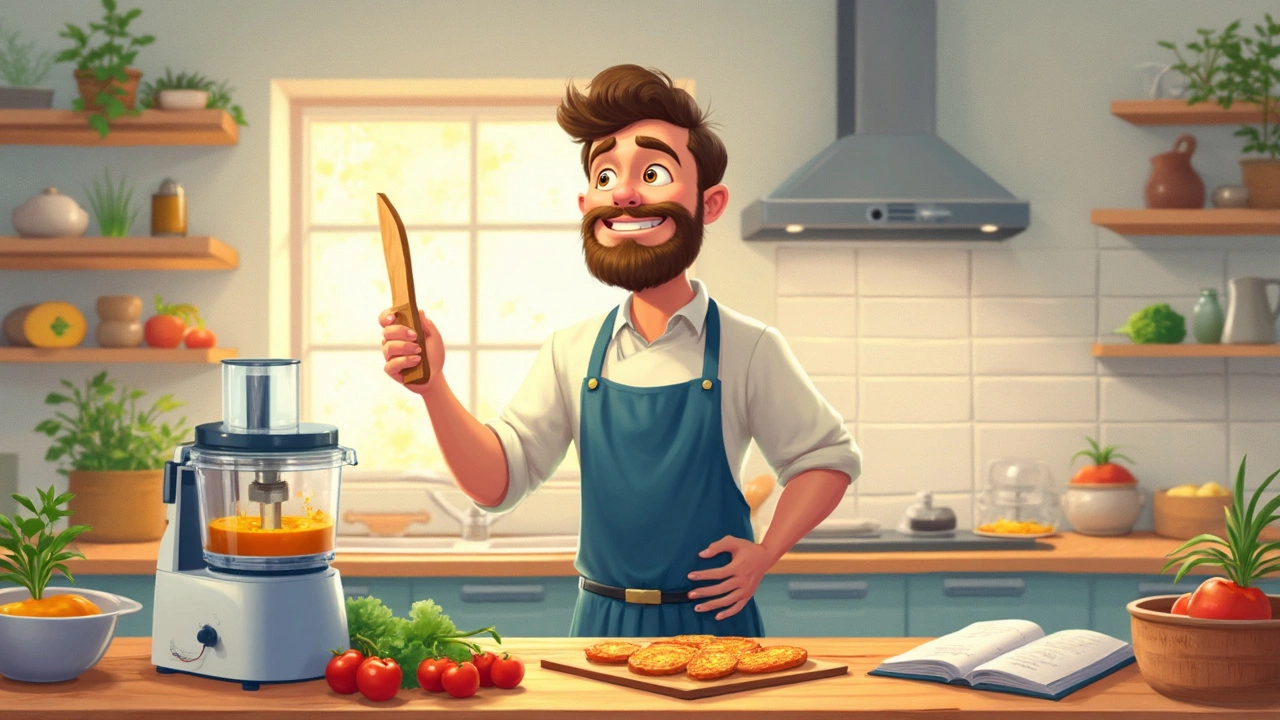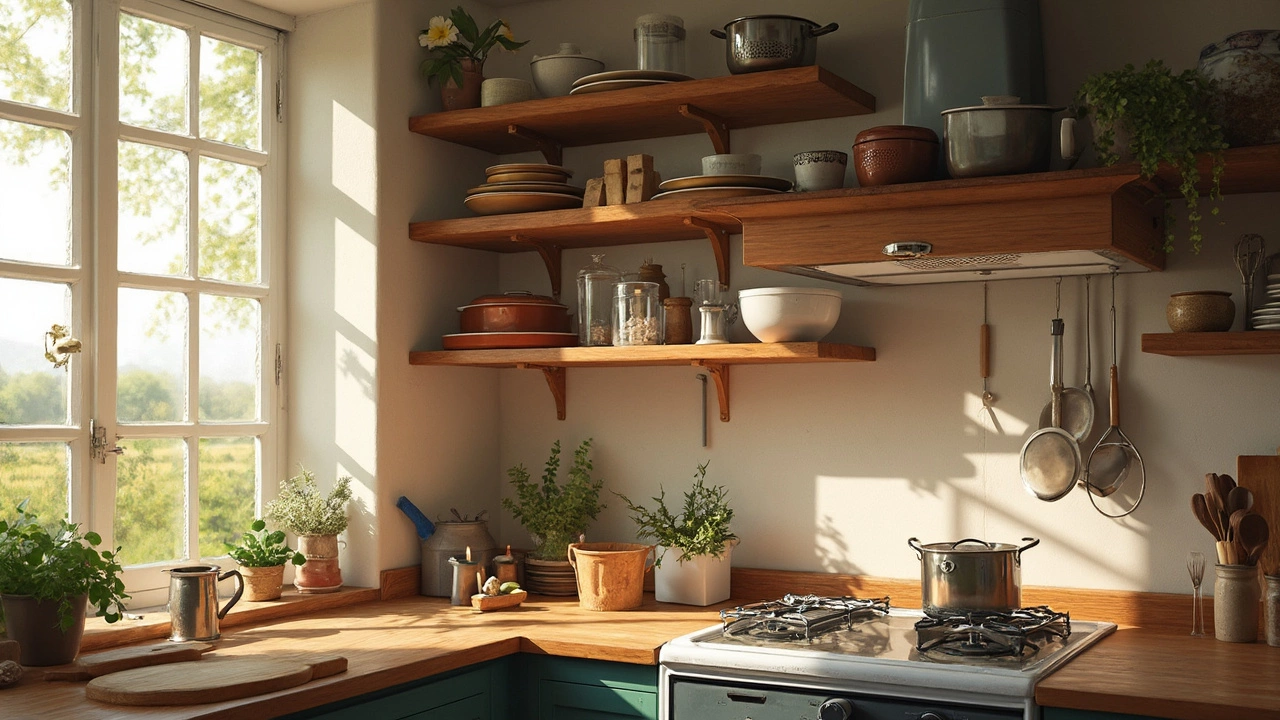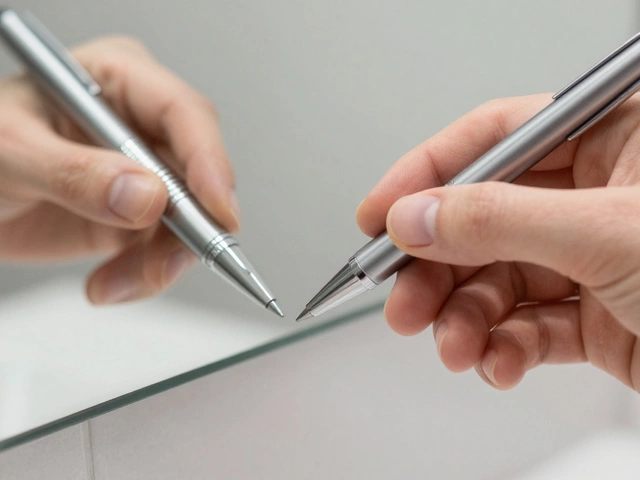Kitchenware might sound straightforward, but lemme tell you, there's more to it than pots and pans! This term covers a whole lot, from the spatula you flip your pancakes with to the pressure cooker you rely on for a quick dinner. The trick is knowing what's what and how to make the most of these tools.
First up, let's chat about what 'kitchenware' really means. It's all the stuff you need to prepare, cook, and even serve food. Think about cutlery, gadgets, and everything in between. Your kitchen might have a treasure trove of gear and understanding each item's role can really step up your cooking game.
- Defining Kitchenware
- Key Categories
- Essential vs. Luxury
- Materials Matter
- Maintenance Tips
- Future Trends
Defining Kitchenware
So, what exactly falls under kitchenware? It's a broad term that captures all those nifty tools and utensils that make cooking a breeze. We're talking about everything from cooking utensils like spatulas and whisks, to cookware like pots and pans, and even those handy kitchen gadgets we can't live without.
Let's break it down: kitchenware typically includes a variety of items grouped into categories. Firstly, there are the essentials, like knives, which are arguably the most important tools you'll own. They're followed closely by pots and pans, which cover the basics for boiling, frying, and roasting. Then come the small but mighty items like measuring cups and spoons, which bring precision to your recipes.
Beyond Basics
Once you've got the essentials, the world of kitchenware opens up to more specialized tools. For instance, there are pasta makers for Italian-night specials and mandolines for perfectly sliced veggies. While not everyone needs these extras, they can sure add a fun twist to your culinary adventures.
How do you choose what you need? It largely depends on your cooking style and space. A minimalist might stick to just the bare bones, while a foodie might collect a tool for each task.
Something for Everyone
The variety in kitchenware reflects the diversity in cooking styles out there. Got a knack for baking? You'll want to stock up on baking trays, mixers, and cake pans. More into grilling? A sturdy set of tongs and a grill pan should be on your list. And let's not forget those quirky bits of kitchenware like avocado slicers and corn on the cob holders that might seem odd, but definitely have their fans.
- Cooking utensils: Spatulas, whisks, tongs
- Cookware: Pots, pans, baking trays
- Gadgets: Food processors, blenders, garlic presses
Remember, kitchen tools and gadgets are there to make life easier, not to overwhelm your space. Choose wisely based on your needs and cooking habits.
Key Categories
Understanding the main categories of kitchenware can help you navigate your kitchen with ease. These categories cover the essentials and can transform your cooking experience.
Cookware
This is the backbone of any kitchen. From pots and pans to skillets and woks, cookware is all about what you use on the stove. Non-stick, stainless steel, and cast iron are popular materials, each with their pros and cons. Non-stick’s great for easy cleanup, while cast iron can give a fantastic sear to steaks.
Utensils
Think about that trusty spatula or your essential slotted spoon. Utensils include everything used to stir, flip, and serve your food. Silicon, wood, metal—each type works differently depending on your cooking style.
Cutlery
You can't forget cutlery—the knives, forks, and spoons. But also those chef’s knives and serrated blades for food prepping. Having razor-sharp knives can make chopping veggies a breeze.
Storage Solutions
Yes, those stacks of plastic containers count! Storage solutions include anything used to preserve your food, like glass jars, Tupperware, and even reusable silicone bags. Keeping things fresh can be more practical with proper containers.
Kitchen Gadgets
This is where tech meets cooking. From blenders to food processors, gadgets help speed up prep times or achieve results that might be tough by hand. Air fryers are currently a big trend; they offer a healthier alternative to traditional frying methods.
No matter what, having a good understanding of these categories lets you equip your kitchen with just what you need. You might be surprised at how the right tools make cooking not only more efficient but a lot more enjoyable too!
Essential vs. Luxury
When it comes to kitchenware, it's easy to get lost between what's absolutely necessary and what's just nice to have. Let's break it down simply: essentials are the workhorses of your kitchen—think chef's knife, cutting board, pots, and pans. These are the things you can't really go without if you're cooking regularly.
Basic Essentials
So, what exactly falls under essential kitchenware? Here's a quick list to keep you sorted:
- Chef's knife - Your go-to blade for pretty much everything.
- Cutting board - Protects your countertops while you chop away.
- Frying pan - Perfect for sautéing or frying.
- Medium saucepan - Great for boiling or making sauces.
- Measuring cups and spoons - Key for baking and precise recipes.
These items form the backbone of most cooking adventures and are where you'd want to invest first. They're foundational and will see you through most recipes.
The Luxurious Extras
Now step into the world of luxurious kitchenware. These aren't strictly necessary but can elevate your cooking. We're talking about high-end gadgets or specialized tools like espresso machines, sous-vide precision cookers, or state-of-the-art mixers.
Here's a look at a few luxuries:
- Stand Mixer - Really helps with baking.
- Pressure Cooker - Speeds up cooking times significantly.
- Espresso Machine - Essential for coffee enthusiasts.
- Food Processor - Makes chopping and pureeing a breeze.
Investing in these is totally up to personal preference and cooking style. While they're not required for basic cooking, they can make food prep faster, easier, and a lot more fun.
Making the Choice
Before splurging on that shiny new gadget, think about how much you'll realistically use it. It's all about finding a balance between practicality and indulgence. If a tool will save you time or enhance your experience significantly, it might be worth considering regardless of its perceived 'luxury' status.

Materials Matter
When it comes to kitchenware, the material can make all the difference. Whether you're selecting a trusty cooking utensil or a durable piece of cookware, understanding materials can help avoid kitchen mishaps and ensure long-lasting tools.
The Usual Suspects: Metals
Let's get started with metals. Stainless steel is a popular choice because it's resistant to rust and easy to clean. It's perfect for pots and pans that need to handle heavy use. On the other hand, cast iron cookware is another classic choice. Though it's heavy, many people love its heat retention and naturally non-stick surface when properly seasoned.
Then there's aluminum, a great conductor of heat. It's lightweight and often found in budget-friendly options. Yet, it’s worth noting that aluminum can warp and isn't always non-stick.
Going Green with Glass and Ceramics
Glass and ceramics are the unsung heroes in some kitchens. They don't react with food, so they're great for storage and baking. Plus, glass offers the advantage of see-through baking dishes, so you can keep an eye on those casseroles.
Plastic: Yay or Nay?
Plastic often gets a bad rap but can be a good choice for its affordability and lightweight nature. It's best for items like measuring cups and mixing bowls. Always check to ensure it's BPA-free to avoid health risks.
Wood: Natural and Time-Tested
Wooden kitchenware, like cutting boards and spoons, has a warm feel and is gentle on your knife edges. Just be sure to dry them properly after washing to prevent warping.
Kanivting for upkeep? Ensuring the right maintenance and selecting quality products are steps toward a well-stocked kitchen that supports you as you whip up culinary delights.
Maintenance Tips
Keeping your kitchenware in top shape can save you a ton of money and hassle down the road. It's like taking care of a good friend; you'll get more mileage out of it!
Dishwasher Dos and Don’ts
Not everything loves the dishwasher. Stainless steel items are usually dish-friendly, but those fancy non-stick pans? Not so much. It's a good rule of thumb to check the manufacturer’s advice before tossing anything in there.
- Stainless steel: Usually safe, but skip harsh detergents.
- Non-stick cookware: Best washed by hand to protect the coating.
- Wooden utensils: Hand wash always, to avoid warping.
Seasoning and Oiling
Keeping cast iron pans seasoned is crucial. This not only prevents rust but also gives that non-stick effect everyone loves.
- Preheat your oven to about 450°F (230°C).
- Apply a thin layer of vegetable oil to your pan, inside and out.
- Place it upside down in the oven (put a foil underneath to catch drips) and bake for an hour.
Storage Smarts
Storing your kitchen tools correctly can add years to their life. Keep sharp knives in a block or on a magnetic strip to protect their edges. Stack pans with care, placing a cloth between each to avoid scratches.
A Little TLC
Once in a while, give your pots and pans a deeper clean to remove any built-up grease or limescale. A simple mix of vinegar and baking soda can work wonders!
Can't remember when your favorite knife was last sharpened? Blunt knives not only make cooking harder but can also be dangerous! Consider investing in a good sharpener or take them to a professional.
Future Trends
As we look to the future of kitchenware, technology is making waves. Smart gadgets are transforming kitchens into tech-savvy hubs. Imagine your fridge helping you track groceries or your oven suggesting recipes based on what's inside! The shift toward connectivity and convenience is blowing our minds.
One significant trend is the rise of eco-friendly materials. Manufacturers are moving away from plastics and toward sustainable options like bamboo, steel, and even recycled goods. It’s not just good for the planet, it’s also stylish. Swanky, right?
According to Mia Collins, a renowned kitchenware designer, "Sustainability is the future. Consumers are becoming more eco-conscious and are actively seeking products that have minimal environmental impact."
Smart Technologies in Kitchenware
Have you heard of smart scales that sync with apps to count calories or smart cookers you can control with your phone? These innovations are a game-changer for both amateur cooks and pros. They simplify processes and make cooking more fun and interactive.
And get this: modular designs are trending too. Think stacking and snapping tools that save space and look chic on your shelves. It’s like kitchen Lego for adults!
| Year | Projected Smart Kitchenware Sales (in billion USD) |
|---|---|
| 2025 | 2.6 |
| 2028 | 4.8 |
So, what's next for kitchen tools? Maybe a spatula that doubles as a Bluetooth speaker? With creativity and tech colliding, the future of cooking looks bright and exciting!







